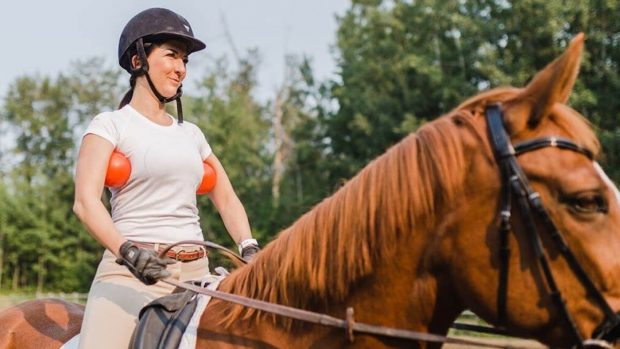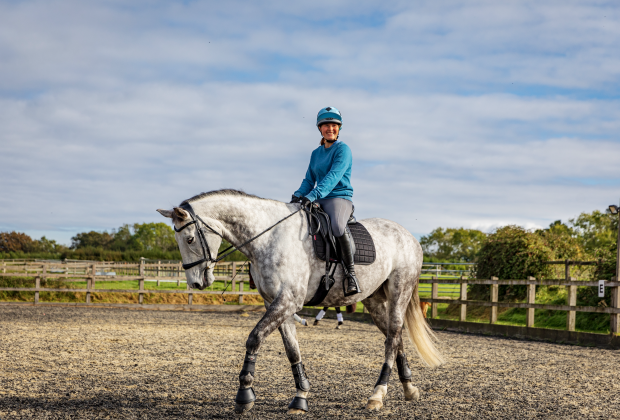Our equestrian teams and individuals were brilliantly successful at the Rio Olympics and I now look forward to watching and supporting the Paralympic teams.
Rio has been a fantastic insight into the level of athleticism and performance that can be achieved through careful production, training and a strong horse-rider partnership. Watching these equestrian athletes at the highest level highlights the importance in maintaining optimal fitness and comfort of the performance horse and also in preventing the risk of injury that may be associated with such high demands of the sport. In fact, all horses can benefit from us thinking about the way in which we train them in order to maximise fitness, comfort and reduction in injury risk.
An important part of the physiotherapist’s role is consideration of the training and management of the horse just as it is with our human athletes. When a horse is referred to physiotherapy due to musculoskeletal pain or impairment for example, having an understanding of the management, fitness and training regime of the horse is a vital component in order to fully treat and rehabilitate the horse from the presenting issue or symptoms.
Factors to consider in promoting horse comfort and performance can be grouped into those that are intrinsic to the horse and those that are extrinsic. For instance, intrinsic factors include the functioning of the musculoskeletal, cardiorespiratory and neurological systems, whereas external factors allude to the environment, coaching methods, equipment and horse husbandry. This blog will briefly consider a few of these components in relation to optimising performance and comfort.
The musculoskeletal system
The horse’s musculoskeletal system takes years to fully mature and growth plates continue to fuse throughout the skeletal system from birth to the age of five or six years of age (or even longer for bigger horses). The growth plates of the distal limb are first to fully fuse and over time they continue to fuse in a proximal direction with the vertebral column being the last place for full growth plate closure. It is important to note that young horses need time to grow and mature and that overtraining in young horses may be counter intuitive to performance longevity and welfare, increasing risk of injury because of the stresses being placed upon an immature skeletal system. Often the elite horses competing in dressage, showjumping and eventing for example are in their mid to late teens because this is the amount of time it has taken to progress them to this level of the sport.
Cardiovascular fitness
Incorporating fitness work into a horse’s training program is a really important part of improving overall conditioning of the horse. In simplistic terms, the cardiovascular system adapts to exercise by promoting hypertrophy of the cardiac muscle and improving efficiency of the heart. This improves the ability to optimally perfuse muscle tissue during exercise, potentially reducing onset on muscle fatigue. This is important for horses competing in a variety of disciplines. Exercise also supports improvements in the size, strength and efficiency of muscle tissue. Effective training programmes should allow time for rest and tissue repair.
Cardiovascular exercise is important from a performance and welfare perspective as in theory the fitter the horse, just like with human athletes, the less predisposed they are to certain injuries associated with lack of fitness or conditioning. A chartered physiotherapist will be keen to explore the type and intensity of training that your horse is carrying out. For example, are the presenting symptoms of the horse secondary to the fact that the horse is not fit enough for the job and compensating in ways which are causing muscle fatigue / pain or is it that the type of fitness work being carried out is not quite having the intended effect and requires some adjusting?
Your physiotherapist can support you in monitoring your horse’s cardiovascular fitness objectively. A simple way of doing this is by incorporating the use of a heart rate monitor in your fitness training in order to determine changes. I will discuss this topic in more detail in a future blog!
Training and mental well-being
Different disciplines place different demands on the horse and may require specific movements and skills from the horse. For example, Flat racing requires speed and length of stride, whereas dressage requires more collection, elevation and lateral movement as well as the ability to extend the stride. In order to improve, the horse needs discipline-specific training. I.e. To improve a horse’s ability to jump, it needs to jump. But there is also an argument to incorporate cross training, not only for physical conditioning (strength, balance, coordination) but also for mental well-being. Studies have shown that stress can predispose a higher risk of injury and/or perception of pain. This is possibly due to a number of reasons including (but not limited to):
1. Increased muscle tension and therefore shortening of certain muscle groups (imagine how you feel when you are stressed and tense through your neck and shoulders)
2. Increased production of stress hormones that can cause a heightened sensitivity to pain and ‘fight or flight’ behaviour patterns. Limiting stress by incorporating cross training methods such as, hacking, fitness work, schooling and gymnastic jumping for example may support mental well-being and welfare as well as physical conditioning.
Training aids and equipment
Tack, training aids and equipment can be a useful tool in helping the horse and/or the rider to achieve a desired outcome i.e. Increased engagement of the hind limb, a softer outline, improved activation of the core muscles. Unfortunately many of the training aids available lack scientific research and rely on anecdotal evidence for their use. There are a multitude of training aids available of varying cost and it can be slightly mind boggling in which to use. Training aids can also cause a multitude of problems if used incorrectly, or if the horse is physically unable to tolerate working in the aid being used secondary to weakness, pain, stiffness or lack of fitness for example. A physiotherapist can support you with this by establishing whether the choice of training aid is appropriate or having the intended effect. Furthermore, advice can be given on ground and ridden exercises (with and without the use of equipment) in order to help attain individual, tailored goals and thereby optimising comfort and performance of the horse.
Shoeing
There have been vast developments in shoeing and the types of materials used by farriers. Interestingly research has shown that during an eight-week period of hoof growth, there is a 3.5-degree change in the dorsal hoof wall angle. This may not sound like much but in fact this increases ground reaction force in the distal limb as well as the strain placed upon the long flexor tendons. This could potentially predispose the horse to injury and therefore presents a good reason to work closely with your farrier in deciding the appropriate length of the horse’s shoeing cycle in order to optimise comfort, performance and reduce risk of injury. Some of the latest research developments look at the effect of different shoeing materials and interfaces on horse biomechanics and forces placed upon the limb. This gives rise to tailoring the horse’s shoe not only to its conformation and biomechanical needs but also to the type of surface it may be required to work/compete on.
Continued below…
Like this? You might also enjoy reading these:
Nina Wareham’s physiotherapy blog: 4 key stretches to improve your horse’s core stability
Nina Wareham’s physiotherapy blog: engagement and core strength — why they are important for your horse
Nina Wareham’s therapy blog: why horses and humans really aren’t that different
This blog has taken a brief look at some of the factors to consider in optimising performance and comfort. Equestrian sport is beginning to see advances in research in relation to performance, biomechanics and exercise physiology. Although slightly behind human research, progress is being made all of the time. This is great news not only for performance but also in optimising the welfare of our horses. Future blogs will explore specific components of training and performance in more detail. Ultimately for me, the important message is that maintaining optimal horse welfare and performance is a combined team effort incorporating the expertise and support from the likes of vets, farriers, trainers, saddle fitters, physiotherapists and of course owners and riders to name but a few!





